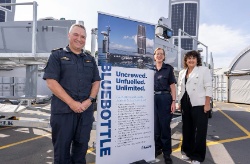Rat monitor trial provides eradication insights
11 May 2017
Rat monitor trial provides eradication insights
A pest monitoring
trial undertaken on the Miramar Peninsula is a first step to
understanding the scale of the predator issue facing the
peninsula as the community gears up to eradicate pests and
bring back birds and other native animals to the
region.
“The monitoring was really useful to
understanding the job in front of us, with recordings of
both target species (rats and mustelids) being made,” says
Dr Philippa Crisp, Team Leader, Terrestrial Ecosystems
and Quality, Greater Wellington Regional Council.
“It is interesting that the greatest numbers of
cards chewed by rats were found on the peninsula coastline.
Some of these sites are areas frequented by people (such as
near carparks or picnic areas). Rats are attracted to food
sources such as rubbish bins and dumping areas.
“There were only a few rat-chewed cards found
in the urban areas, but this may be where the cards were
placed, rather than because the rats weren’t present. For
practical reasons, the cards were placed on street verges,
but there may have been more rat chews recorded if they were
positioned in back yards.”
Project
director for Predator Free Wellington James Willcocks says
the research will provide a benchmark against which
populations will be monitored. “Local trapping groups are
already out there doing a great job knocking back rat
numbers. Data showing the impact of their activity on rat
populations will help target eradication efforts.
Dr Crisp says that more research may be needed to ensure the eradication campaign is well targeted, including using cameras at some sites to properly identify the chews seen on cards and to encourage people to place cards in their backyards next time the monitor is completed
Another possible avenue of investigation could be of the
distribution of ship versus Norway rats as it is suspected
that many of the rats recorded by the chew cards around the
coast may have been Norway rats. This is important for bird
conservation as Norway rats show less of a willingness to
climb and so are believed to have less of an impact on
tree-roosting bird populations than ship rats.
The results of the survey were as
follows:
• Rat chews were found on 12% of
the cards (31 out of 257). By far the most chewed cards were
found around the coastline.
• Six of the 257
retrieved cards (2%) were identified as mustelid. These were
found in areas of natural bush.
• Additionally
chew marks of other species such as hedgehogs and mice were
identified on the chew cards.
Predator Free Wellington is
a partnership between Greater Wellington Regional Council,
Wellington City Council and the NEXT Foundation, the
objective of which is to eradicate predators in Wellington
City to promote biodiversity within its borders.
For more information about the Predator Free Wellington project please visit wellington.govt.nz/predatorfree
ends


 Gordon Campbell: On The Left’s Electability Crisis, And The Abundance Ecotopia
Gordon Campbell: On The Left’s Electability Crisis, And The Abundance Ecotopia NZ Government: Stay Safe On Our Roads This Easter
NZ Government: Stay Safe On Our Roads This Easter YWCA: Global Push Back Against Gender Equality A Growing Crisis In Aotearoa
YWCA: Global Push Back Against Gender Equality A Growing Crisis In Aotearoa Te Pāti Māori: Ngarewa-Packer - Fast-Tracking Seabed Mining Ignores Māori Opposition And Environmental Precedent
Te Pāti Māori: Ngarewa-Packer - Fast-Tracking Seabed Mining Ignores Māori Opposition And Environmental Precedent New Zealand Defence Force: Defence And Customs Strengthen Maritime Security With Uncrewed Surface Vessels
New Zealand Defence Force: Defence And Customs Strengthen Maritime Security With Uncrewed Surface Vessels SPCA: Huge Win With New Dog Tethering Regulations
SPCA: Huge Win With New Dog Tethering Regulations Community Housing Aotearoa: Ngā Wharerau o Aotearoa Says New Partnership Model Helping Ensure Right To A Decent Home Is Realised
Community Housing Aotearoa: Ngā Wharerau o Aotearoa Says New Partnership Model Helping Ensure Right To A Decent Home Is Realised


